Indian roads are humming with the quiet revolution of electric vehicles. In FY 2024–25, EVs made up 7.8% of total automobile sales, marking a clear shift in consumer choice and policy push. Valued at USD 8.49 billion in 2024, the market is projected to grow at a blistering 40.7% CAGR from 2025 to 2030.
AI drives growth by improving battery management, predictive maintenance, autonomous features, and smart charging, helping OEMs enhance manufacturing, customer experience, and agility.
The industry’s value, which had been estimated at USD 8.49 billion in 2024, is set to rise at breakneck speed, with a projected CAGR of 40.7% between 2025 and 2030.
This guide explores how AI is shaping EV adoption in India for OEMs, automotive leaders, investors, and tech innovators. Let’s embark on this learning journey and see how you, as an OEM partner, can lead the charge in India EV Market Growth; a market that’s brimming with potential.
Current State of India’s EV Market in 2025
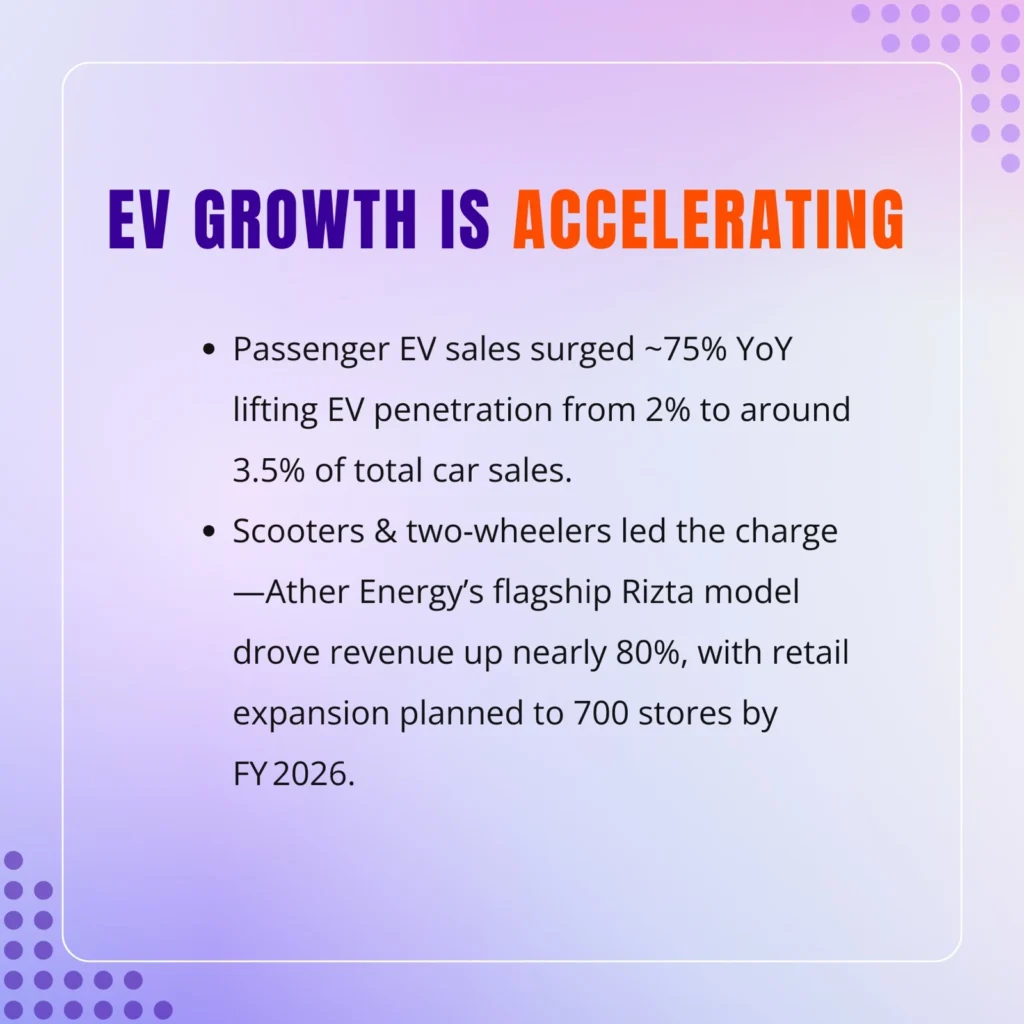
While we already talked about this briefly. Let’s go a bit deeper. To begin our deep dive into India EV Market Growth, let us first look into:
Market size and growth metrics
This metric is really tricky to keep track of because India’s EV market is changing quickly. In 2024, EV sales reached approximately 1.9 million units, marking a 19% year-over-year jump from 2023 levels.
Another important detail here is that 59% of the total EV sales is driven by two-wheelers. Three-wheelers come in second with 35% of the market share.
If we are talking revenue, then the industry stood at an estimated USD 11.36 billion in 2024, and in 2025, it stands at around USD 18.79 billion by 2025 with a steep CAGR of 57.3% projected through 2034.
Another exciting part of the market comes out when we look at segment-wise trends. As mentioned before, two-wheelers are leading. But passenger cars are also showing a great deal of promise. Car/SUV EV purchases crossed the 100,000 units mark with 18.2% growth in FY2025.
And it’s not just the consumer side that’s making the effort. Automotive giants are stepping up as well. Electric cars made up just 2.5% of the 4 million cars sold last year, but India is targeting a leap to 30% EV penetration in passenger vehicles by 2030.
India EV Market Growth: Key market players and ecosystem
The India EV Market Growth, like any other country, is quite complex. There’s a mix of the local heroes and the global giants, all wanting a share of the market. Let’s take a look at all of them.
The domestic players
- Tata Motors held a dominant 73% share of the electric passenger vehicle market as of early 2025. But a surge in rival launches and their quick adoption by EV buyers has eroded Tata’s lead. Their current share is 35%.
- Ola Electric leads the electric two-wheeler space, capturing over 30% market share.
- Mahindra & Mahindra is strategically focused on electric SUVs, aiming for 20-30% of its SUV sales to be electric by 2027.
Global entrants
- VinFast (Vietnam) is establishing a Tamil Nadu plant with a 50,000-unit annual capacity that focuses on e-SUVs and fleet solutions.
- BYD (China) is targeting the B2B fleet and premium SUV market.
- MG Motor India (now majority-owned by JSW Group) is accelerating localisation with a 50 GWh battery plant in Odisha.
Supplier and component ecosystem
- Battery Manufacturing: India’s ACC PLI scheme is spurring domestic gigafactory investments from Reliance New Energy, Exide, and Amara Raja.
- Charging Infrastructure Providers: Tata Power, Statiq, and ChargeZone are expanding into Tier-2/3 cities, which is critical for mass adoption.
- Software & AI Providers: Tech giants like TCS and KPIT are entering EV telematics, ADAS integration, and AI-powered BMS solutions.
Strategic insights for OEM partners
Here’s what you can glean from the above trends:
- Joint ventures with the local companies can be really profitable. If you can partner up with leaders like Tata or Mahindra, you will get instant distribution networks.
- One section that remains relatively unexplored is the luxury segment. The penetration here is less than 11%. This creates a lot of space in this area.
- Domestic suppliers are scaling really fast. This means a large section of the components required for manufacturing will be easily available.
Infrastructure development
EV charging infrastructure in India is growing but still lagging. According to Economic Times, public charging stations grew fivefold between FY22 and early FY25, rising from ~5,150 units to around 26,367.
Yet, the ratio remains imbalanced. India currently offers just one public charger per 235 EVs. This number is far below the global average.
On the positive side, the states that are leading in charging infrastructure include Karnataka, Maharashtra, and Uttar Pradesh.
Also, the PM E-DRIVE scheme has pledged ₹2,000 crore for charging infrastructure, ₹500 crore for electric trucks, and ₹4,391 crore for electric buses.
The AI Revolution in India EV Market Growth
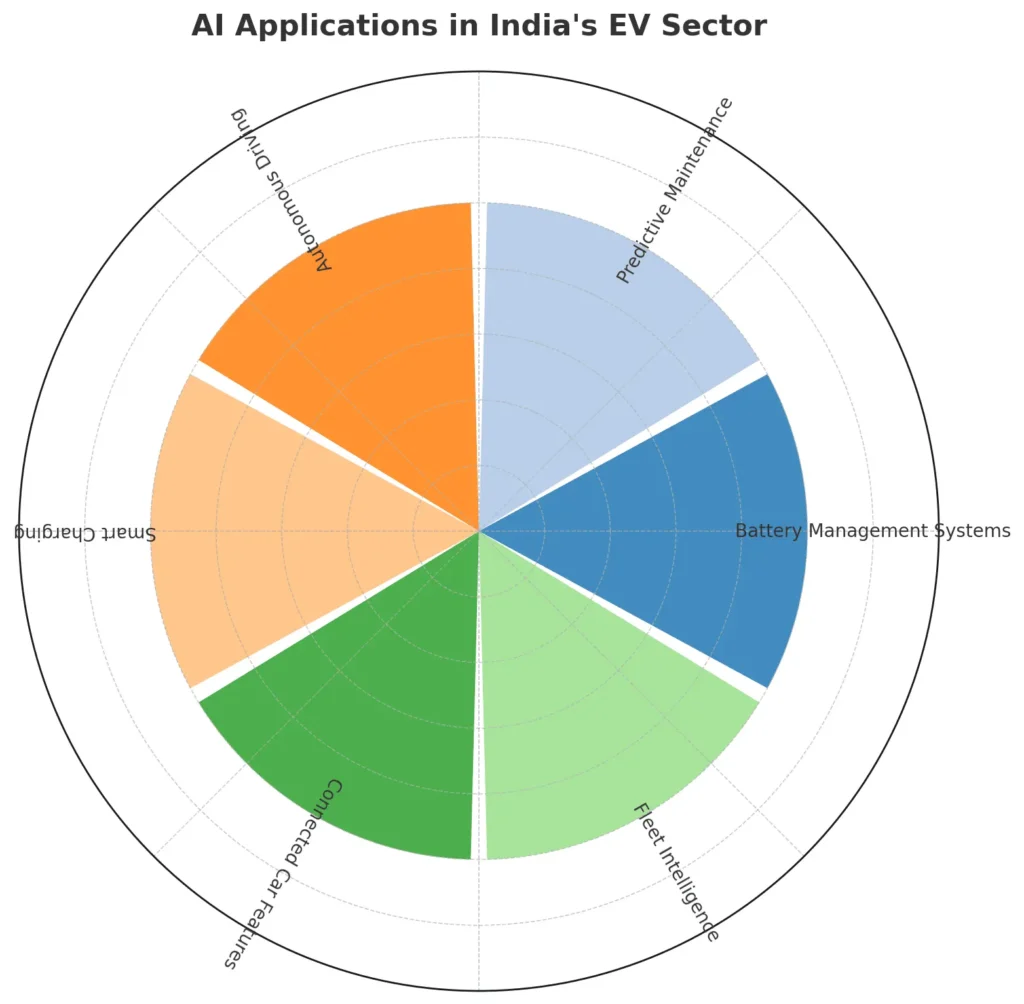
AI has risen from being a simple add-on to dominating the path to higher efficiency, road safety, and ecosystem intelligence. Here are some sectors where AI is making strides:
Battery management systems (BMS) and smart charging
Auto Expo 2025 highlighted AI in battery management systems, featuring innovations like machine learning for energy prediction, self-learning charging, and real-time thermal monitoring to reduce degradation and maintenance costs.
Predictive maintenance, diagnostics and fleet intelligence
Amphion Mobility leads the sector with AI-powered analytics that track battery health, predict failures, and optimize routes, helping fleets maximize uptime, reduce breakdowns, and manage proactive battery replacements.
Autonomous driving and road hazard detection
Researchers in Hyderabad developed an autonomous EV concept that spots potholes and road hazards with 80% accuracy using deep learning. This tech is not just a luxury but kind of essential, given the condition of India’s roads.
Connected car features
Features like adaptive cruise control, lane keep assist, and emergency braking, powered by sensor fusion and AI reasoning, are gaining traction.
AI-powered manufacturing and production
AI is taking over on the factory floor, too. Here’s how:
- Quality control and defect detection: AI-powered systems are being deployed to detect defects early in battery cell manufacturing and assembly. This prevents failures and improves overall yields.
- Predictive analytics and supply chain optimization: AI algorithms track inventory trends, forecast parts demand, and stabilize manufacturing flow by predicting disruptions ahead of time.
- Robotics and smart assembly lines: At Ola Electric’s Pochampalli Gigafactory, advanced robots handle welding, painting, and battery-motor assembly. This streamlines the production of EVs with the consistent use of AI.
Connected vehicle tech
AI doesn’t have to exist just within a vehicle or within the factories. It is what connects your EVs to the rest of the world. And here’s how it does it.
- IoT, V2X, and real-time connectivity: India’s V2X rollout and connected platforms like Tata’s iRA, MG’s i-SMART, and Mahindra’s AdrenoX are enabling AI-driven traffic, infrastructure, and safety enhancements..
- Over-the-Air (OTA) updates and voice-native experiences: Car platforms deliver OTA upgrades, safety patches, and infotainment. MG’s i-SMART 2.0 supports 100+ voice commands in regional languages and Hinglish, backed by Microsoft, Jio, and Adobe.
AI-Driven Opportunities for OEM Partners
India’s EV market is evolving rapidly, no longer new but not yet fully mature. The key is not whether to adopt AI, but how strategically and quickly. Let’s explore top AI impact points, partnership models, and business strategies.
Technology partnership opportunities
- Battery as a Service
Collaborate with innovators like SUN Mobility, which operates over 600 battery swapping points nationwide and dominates e-three-wheeler and swappable e-bike segments.
- Smart charging and infrastructure integration
Partner with utilities and startups joining forces, such as BSES Yamuna Power’s collaboration with EV Motors India, to deploy AI-driven, cloud-enabled charging networks that adapt dynamically to grid load and EV demand.
- AI-enhanced fleet solutions and analytics
Use AI to optimize routing, battery health, and vehicle utilization. This aligns with logistics trends supplied by The Economic Times, which says that by 2025, last-mile EV fleets will be propelled by battery analytics and AI to minimize operational costs and maximize efficiency.
- Precision steering and autonomous support systems
As an OEM, you can license AI-embedded technologies like Intelligent Electric Power Steering (EPS), which delivers adaptive torque management and predictive diagnostics for safer, smoother driving.
Market entry strategies for global OEMs
- Form joint ventures for fast market penetration: Make use of an Indian OEM’s manufacturing base while bringing your AI tech IP to the table. Tata Motors just signed an MoU to supply 100 Magna EV coaches to Universal Bus Services in Tamil Nadu.
Your entry point could be a JV like that one, too.
- Set up local SKD/CKD operations to qualify for PLI perks: Tata just announced ₹33,000–₹35,000 crore investments through FY26–30 to expand its passenger EV models. By localizing assembly and integrating AI-driven manufacturing, you can access cost rebates and tariffs under India’s PLI scheme.
Specific AI-driven business models
In this section, we will explore, in detail, what you can add to the industry and how you can carve yourself a piece of the EV pie.
- Battery tech and recycling efficiency
SUN Mobility’s battery-swapping stations cut upfront costs of heavy EVs by 40% and operational costs by 20%, with swap times under 3 minutes. This means they are focusing on efficiency a lot. As an OEM, you could offer them AI-enabled sorting or second-life battery prediction models, boosting recycling yield and lifecycle tracking.
- ADAS made for Indian roads
Tata’s Harrier.ev, launched mid-2025, brings ADAS into India’s mid-size EV segment, upping the premium game. Similarly, you can adapt your L2–3 stack with ML models trained on Indian traffic and infrastructure data for this rising segment.
- Smart manufacturing
Ola Electric’s Future Factory in Tamil Nadu uses heavy automation and robotics for efficient EV manufacturing. You can offer your AI manufacturing platform that simulates these lines (digital twin).
- AI-driven after-sales and OTA ecosystems
While there is no explicit Indian example of this happening yet, Tata’s forthcoming EV models hint at connected platforms, setting the stage. You could supply multilingual voice bots, OTA management tools, and AI-driven support dashboards, positioning OEMs to lead the post-sale experience.
Challenges and Solutions for OEM Implementation
The EV landscape is growing and changing at a rapid pace. Let’s start by analyzing the challenges.
Technical challenges
- Fragile grid and infrastructure bottlenecks
India’s power grid struggles with reliability a lot. Peak load shedding, surcharge risk, and uneven distribution are common, especially outside tier-1 cities. If you try to deploy EVs at scale without infrastructure adaptation, you risk overloading systems and frustrating consumers.
What you can do: Co-develop smart-charging systems with utilities and local distribution companies (DISCOMs), integrating AI for demand shaping. Preempt congestion by piloting vehicle-to-grid (V2G) or off-peak charging schemes in metro areas.
- Supply chain localization pressures and cost sensitivity
India has pushed localization a ton. This is highlighted by the SPMEPCI demanding up to 50% Domestic Value Addition (DVA) within five years, raising both cost and complexity. Some OEMs have paused applications due to steep investment and unclear incentives.
What you can do: Initiate phased localization with tier-1 partners. Use your global economies of scale to support joint ventures or component bundling, easing the DVA burden and minimizing import costs.
- Lack of unified policy and regulatory inconsistencies
EV regulations, including FAME, EV manufacturing mandates, and changing norms, vary between states and change frequently. This creates a lot of planning uncertainty.
What you can do: Negotiate multi-state MOUs with local governments to pilot uniform standards in EV zones or export hubs. This offers a ton of regulatory predictability.
Regulatory and policy considerations
- Excessive barriers under SPMEPCI
The new electric car manufacturing policy demands a ₹4,150 crore minimum investment and strict DVA targets, yet zero OEMs have applied so far due to the onerous conditions.
What you can do: Advocate for eased thresholds and co-develop ‘brownfield exceptions’ that let you phase investments over time. Meanwhile, leverage FTA-based import pathways while building local capacity.
- Charging standards and taxation complexities
Despite GST benefits, component-level GST rates (e.g., 18% on batteries) and inconsistent charger standards burden cost reduction and consumer confidence.
What you can do: Lead a consortium of OEMs and suppliers to petition regulators for a unified tax and charger standard framework. Joint efforts can deliver consumer clarity and scale savings.
- Rapid policy shifts and weak after-sales framework
FAME subsidy uncertainty and weak service infrastructure continue to deter adoption, especially in EV-rich states, where repair networks and trained staff are just emerging.
What you can do: Build dedicated EV service centers in key regions. Use your brand to train local technicians under ‘EV Master Tech’ programs, perhaps in partnership with OEMs like Ola or Okinawa.
Market-specific adaptations
- Cost-conscious consumers
With EV prices higher than ICE equivalents, Indian buyers remain cautious. Two-wheelers sold better than four-wheelers. And hybrid options are still very popular too.
What you can do: Launch modular EV models. Offer entry-level versions with optional AI enhancements through subscriptions (like AI diagnostics or smart OTA features). This allows buyers to upgrade and pay as they gain more confidence in the product.
- Harsh operating conditions
India’s climate extremes, mixed road types, and traffic density demand rugged ADAS and thermal resilience. But most global models don’t account for this.
What you can do: Localize AI training datasets by collaborating with local OEMs on urban driving data. Use these to adapt your ADAS stack, making it pothole-aware, heat-tolerant, and climate-robust.
- Infrastructure variability across regions
States like Uttar Pradesh are investing in EV policies and charging hubs. But a ton of others are lagging behind.
What you can do: Adapt a geo-targeted rollout. Prioritize EV launches in proactive states first. Then move on to the others when infrastructure inevitably catches up.
India EV Market Growth: Strategic solutions and best practices
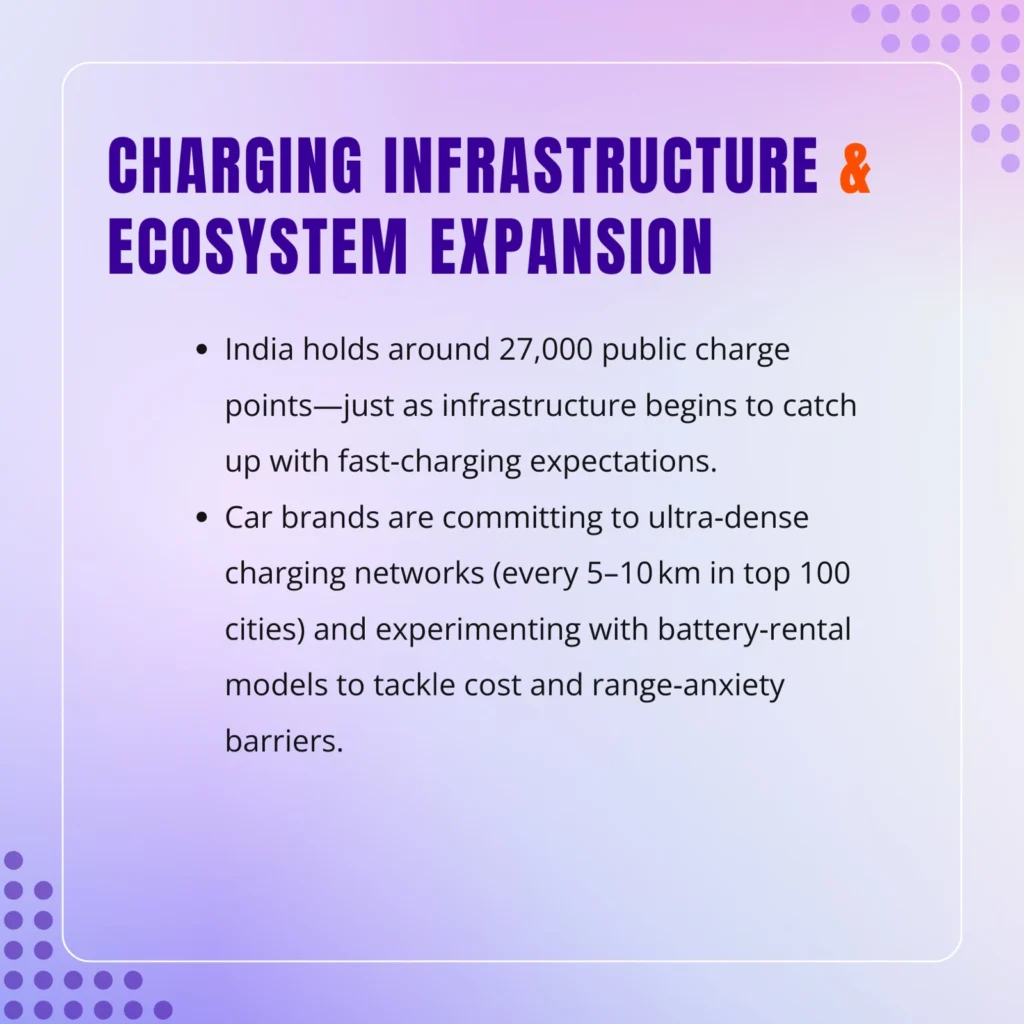
We already talked about specific solutions to specific problems. But there are some general things you can do to avoid too many hiccups overall. Let’s go over them:
- Phased rollout frameworks: Start with pilot zones and electric two-/three-wheeler corridors, and roll out successively to metro and tier-2 markets. Make use of Charger-Backed Lease (CBL) programs bundled with AI services to alleviate consumer hesitation.
- Partnership-first localization: Team up with domestic juggernauts like Tata, Mahindra, and VinFast for shared R&D, joint manufacturing, and policy insurance. East-West tech exchange plus domestic scale can accelerate your path to profitability.
- Skill ecosystem building: Establish training academies in collaboration with NITI Aayog or leading IITs to build a skilled aftermarket and AI engineering workforce. These form the backbone of a future-proof EV partner ecosystem.
- Risk mitigation via dual-sourcing: Hedge against component price fluctuations by diversifying suppliers between local and global. Use AI to optimize which sourcing channel is cost-effective in real time.
Future Roadmap: India EV Market Growth Forecast 2025–2030
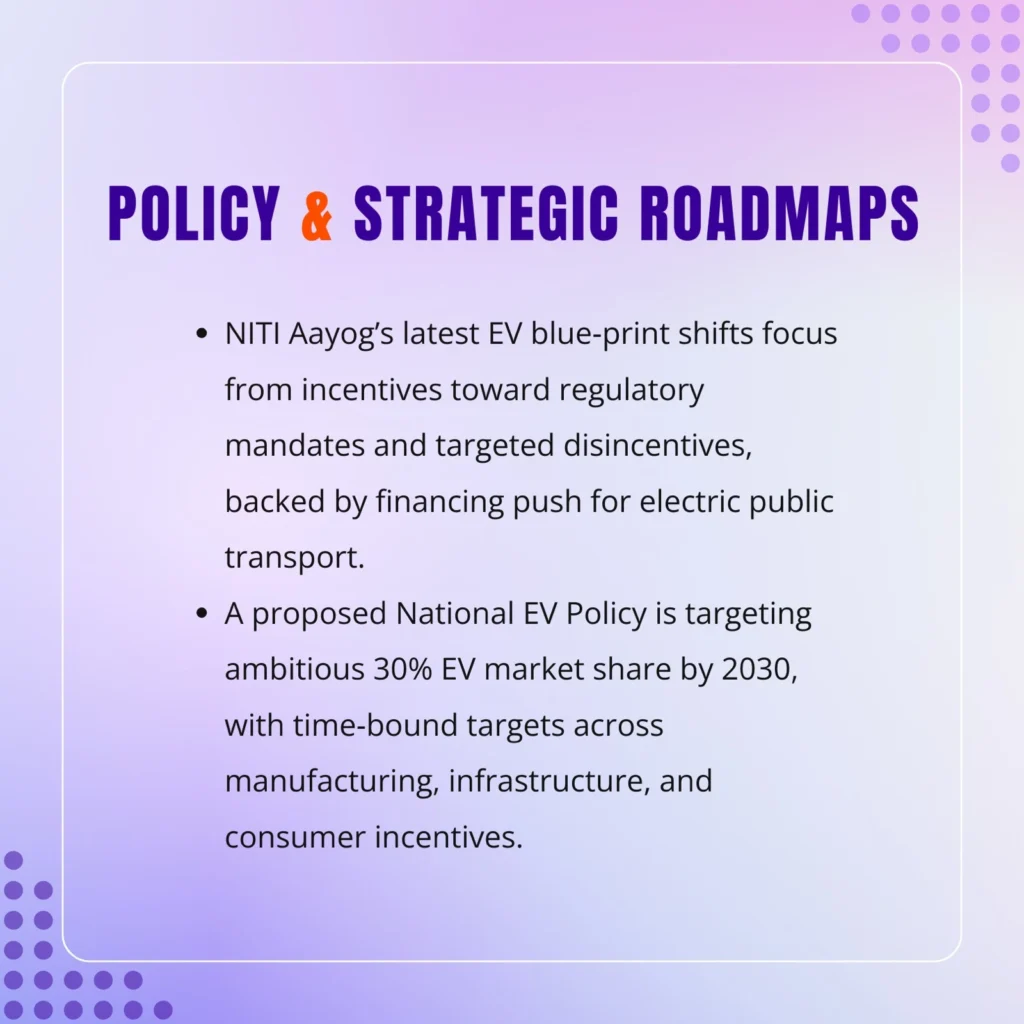
Now that we have explored the challenging areas and solutions, let’s see the upcoming trends, so you know what
Growth Projections and Trends
- EV penetration will cross 30% by 2030
NITI Aayog projects that EVs will make up 30% of total new vehicle sales by 2030, with two- and three-wheelers dominating the adoption curve. Passenger EVs are expected to grow at a CAGR of over 35%, driven by cost parity with ICE in urban markets.
Opportunity for you: Start product localization now to hit the mass-market inflection point expected in 2027–2028.
- Charging infrastructure to reach 1.3 million stations
India’s Ministry of Power aims to deploy over 1.3 million public charging stations by 2030 with a strong emphasis on DC fast chargers along highways.
Opportunity for you: Collaborate with infra players like Tata Power or ChargeZone to integrate AI-driven load balancing and predictive maintenance into charging networks.
- Battery cost parity with ICE
BloombergNEF forecasts that EV battery prices will fall below $100/kWh by 2027, making EVs cheaper to own than ICEs without subsidies.
Opportunity for you: Introduce AI-optimized battery packs to improve lifespan, especially in India’s high-temperature regions.
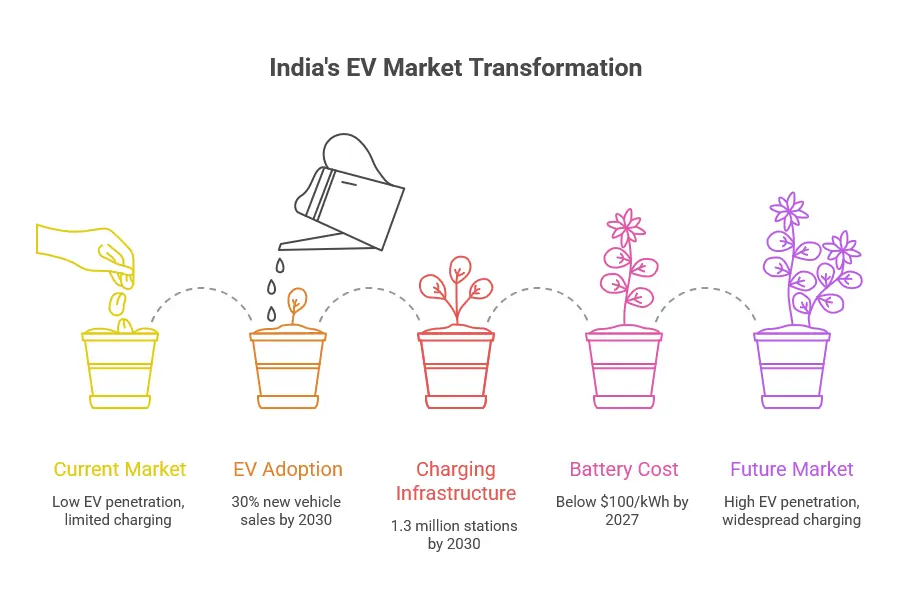
Emerging technologies and opportunities
- Next-gen solid-state batteries
Indian OEMs are beginning pilot programs with solid-state cells. Ola Electric announced R&D efforts in 2024.
Opportunity for you: Partner on join trials, providing AI thermal management algorithms to accelerate commercialization.
- Vehicle-to-Everything (V2X) integration
5G-enabled V2X services are being tested in Pune’s smart city corridors.
Opportunity for you: Localize AI-based V2G and V2I communication systems for traffic optimization.
- Advanced Driver Assistance Systems (ADAS) tuned for India
Mahindra’s XUV400 EV is testing Level 2 ADAS with AI-based pedestrian and cyclist detection adapted for Indian road patterns.
Opportunity for you: License your AI perception stack for Level 2-3 features optimized for dense, mixed traffic conditions.
Regional market development
- Tier-1 vs Tier-2 adoption
Tier-1 cities like Delhi, Mumbai, and Bengaluru will see EV penetration above 35% by 2030, but Tier-2 cities are expected to grow faster percentage-wise due to falling EV prices and state incentives.
Opportunity for you: Establish early dealership and service presence in Tier-2 hubs like Jaipur, Indore, and Coimbatore before competition saturates.
- State-led incentives
States like Gujarat, Maharashtra, and Tamil Nadu are offering up to ₹20,000 per two-wheeler and ₹1.5 lakh per four-wheeler EV in subsidies.
Opportunity for you: Align product launches with state EV policy timelines to maximize sales.
How To Get Started: The Complete Action Plan For OEMs
Let’s tackle this on a timeline to make things easier for you.
0-6 months: Lay the groundwork
- Conduct market feasibility study focused on 2W, 3W, and urban 4W EV demand.
- Secure local AI technology and battery management partners.
- Initiate compliance with India’s CMVR, AIS safety norms, and FAME-II eligibility.
6-18 months: Build and localize
- Set up assembly/manufacturing in EV-friendly states to leverage PLI benefits.
- Localize battery packs and thermal management for Indian climate.
- Deploy AI-powered manufacturing for defect reduction and supply chain optimization.
18+ months: Scale for leadership
- Expand into tier-2 and tier-3 cities ahead of mass adoption.
- Diversify into autonomous-ready and connected EV services.
- Commit to closed-loop battery recycling aligning with India’s sustainability goals.
The key metrics that you have to look out for throughout this journey include market share growth (segment-wise), AI feature adoption rates, partnership ROI, and customer satisfaction scores.
Lead The AI Charge with DaveAI
India EV market growth in 2025 is at its turning point, and this is exactly when you need to jump in to become a top player. And AI is the X-factor that will set you apart from your competitors. It can take up a place in manufacturing floors, all the way up to customer dashboards.
But the opportunity doesn’t stop just at the engineering part of it. You can also use AI to revolutionize EV sales with tools like DaveAI’s virtual sales avatars, AI-powered chatbot, and immersive digital showrooms that have already helped brands like Maruti Suzuki and BYD.
Want to know more about that? Book a demo with DaveAI today.



